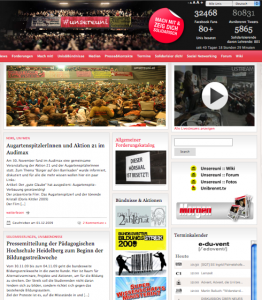Did you know that at this very moment many universities throughout Europe are occupied by students? Thousands of them are sleeping, cooking, debating and partying in their auditoriums to protest against the under-financing of the educational system and the so-called Bologna Process, a European Union education policy.
What is so special about these protests is the fact that they have not been centrally coordinated by student unions but have been organized entirely bottom-up, with the help of online social media.
It all started in Vienna, Austria on October 22, when a small group of students met for a flashmob in the city center to protest, and then headed to University of Vienna where they spontaneously occupied the Auditorium Maximum. By the time police arrived, the news of the occupation had already circulated on Twitter, mobilizing so many supporters it was impossible to clear the hall.
Within days, the occupiers – to their own surprise – put in place a remarkable organizational structure: Mobilization and communication was organized via the Twitter “hashtags” #unibrennt and #unsereuni (“university on fire” and “our university”).A 24h webcast from the Auditorium Maximum was put in place. Organizational tasks from cooking to cleaning were structured via a wiki, and a website communicated with the public. Twitter, blogs and Facebook (32,400 fans so far) were used to spread the word.
This had two effects:
- For the first time protests of this scale did not need the support of mass media for mobilization. Within less than a week after the beginning of the protests more than 20,000 demonstrators roamed the streets of Vienna, preceding any mass media coverage. Media contacts were limited to a bare minimum (which produced much confusion). Students simply didn‘t need the media and since the protests lacked hierarchy, there was a shortage of spokespersons.
- Second, because everyone could follow what was going on inside the Auditorium Maximum (the webcast produced half a million views within one month) it kept the tabloid press from labeling the protesters as rioters or extremists. Too many people knew it wasn‘t true. The power of opinion-making had shifted.
Soon the protests infected other university cities in Austria and abroad: Today, less than a month and a half after the first protests, almost 100 universities in Austria, Germany, Switzerland, Albania, Serbia, France, Italy, Croatia and the Netherlands are occupied or have seen other forms of mass protest.
On Wissen belastet, Max Kossatz, a blogger and media observer from Austria, has analyzed [de] the Twitter stream: 66,379 tweets by 6,780 different usernames have been published on the subject in the last month. 1,043 pictures were posted on Twitpic and produced 125,612 views – see this Twitpic photo mashup on Youtube. And especially interesting, is the following map of tweets that illustrates how the protests spread over time (watch in HD and fullscreen to get the full experience):
Gerald Bäck of Bäck Blog, who works in the media observation business, found out that the gross reach of the tweets, i.e. the unique number of followers exposed to them, was 386,860. His analysis [de] shows who the key influencers were, what URLs were most linked to and what hashtags were used most.
In his blog, smime, Michael Schuster who is specialist in semantic analysis, contributed an overview [de] of the “old media” covering the events. He counted 2,700 articles and identified four trends lasting roughly one week each: “Protests take place”, “protests continue”, “protests widen”, and recently, “ok, enough now.”
Luca Hammer of 2-Blog, a student and technical mastermind behind the Viennese web activities, has published a field report [de] of how wikis, Twitter and webcast were used to get things rolling.
It looks like the case of #unibrennt may become an early milestone in the transformation of Austrian politics by the use of online social media. It has created wide attention – and confusion – among established media and political structures, and created a spirit of empowerment among students and digital leaders.








7 comments
Photo in the Vienna edition of today’s Österreich newspaper appears to back-up the newspaper’s claim that the sit-in students at Vienna Uni’s Audi Max return to their various accomodations in the evenings and leave the Audi Max in the care of twenty or so homeless, in off the cold streets to spend warm nights in there. A noble gesture!